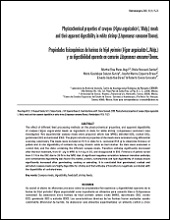Propiedades fisicoquímicas de harinas de frijol yorimón (Vigna unguiculata L. Walp.) y su digestibilidad aparente en camarón Litopenaeus vannamei Boone.
Physicochemical properties of cowpea (Vigna unguiculata L. Walp.) meals and their apparent digestibility in white shrimp (Litopenaeus vannamei Boone).
Autor
MARTHA ELISA RIVAS VEGA
OFELIA ROUZAUD SANDEZ
MARIA GUADALUPE SALAZAR GARCIA
JOSAFAT MARINA EZQUERRA BRAUER
ERNESTO GOYTORTUA BORES
ROBERTO CIVERA CERECEDO
Metadatos
Mostrar el registro completo del ítemResumen
"Se evaluó el efecto de diferentes procesos sobre las propiedades fisicoquímicas y digestibilidad aparente de la
harina de frijol yorimón (Vigna unguiculata) como ingrediente en alimentos para camarón blanco (Litopenaeus
vannamei). Se elaboraron cinco harinas de frijol yorimón: entero crudo (WRC), decorticado (DC), cocido
(CC), germinado (GC) y extruido (EXC). Las características térmicas de las harinas fueron evaluadas usando
calorimetría diferencial de barrido. Se elaboraron seis alimentos experimentales: un alimento control y cinco alimentos conteniendo 15 % de las diferentes harinas de frijol yorimón. A estos alimentos se le determinó firmeza
y digestibilidad in vivo de nutrientes para L. vannamei (15.4 g) usando óxido de cromo como marcador inerte.
La entalpía de transición decreció después del tratamiento térmico, de 6.1 J/g en la WRC a 1.4 J/g en la CC, y
desapareció en la EXC. La firmeza de los alimentos varió de 1.1 N en el alimento con EXC a 2.8 N en el alimento
con WRC. Se encontró una correlación significativa negativa entre la entalpía de transición y la digestibilidad de
carbohidratos de la harina del frijol yorimón. La digestibilidad de materia seca, proteína, carbohidratos y lípidos de
las harinas de frijol yorimón aumentó significativamente con el germinado, la cocción y la extrusión. En el presente
estudio se concluye que las harinas de frijol yorimón germinado, cocido y extruido son altamente digeribles para
camarón L. vannamei, y la entalpía de transición se correlaciona significativamente con la digestibilidad de los
carbohidratos." "The effect of different feed processing methods on the physicochemical properties, and apparent digestibility
of cowpea (Vigna unguiculata) meals as ingredients in diets for white shrimp ( Litopenaeus vannamei ) was
investigated. Five experimental cowpea meals were prepared: whole raw (WRC), dehulled (DC), cooked (CC),
germinated (GC) and extruded (EXC). The physicochemical properties of the meals were evaluated using differential
scanning calorimetry. The meals were included at 15 % in diets for L. vannamei (15.4 g) to determine firmness of
pellets and in vivo digestibility of nutrients by using chromic oxide as inert marker. Six diets were evaluated: a
control diet, and five diets containing the different cowpea meals. Transition enthalpy significantly decreased
after thermal treatment, from 6.1 J/g in WRC to 1.4 J/g in CC, and disappeared in EXC. Firmness of pellets varied
from 1.1 N in the EXC diet to 2.8 N in the WRC diet. A significant negative correlation between transition enthalpy
and carbohydrate digestibility was found. Dry matter, protein, carbohydrate and lipid digestibility of cowpea meals
significantly increased after germinating, cooking or extruding. It is concluded that germinated, cooked and
extruded cowpea meals are highly digestible for shrimp and that enthalpy of transition is negatively correlated with
the digestibility of carbohydrates."

